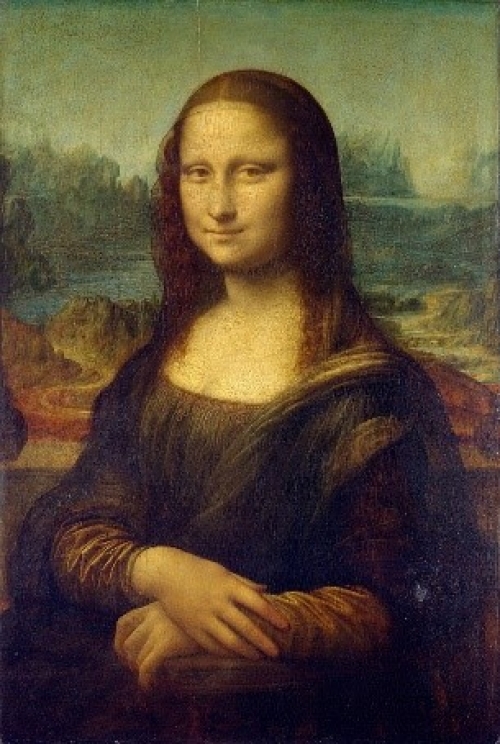Leonardo da Vinci, the Mona Lisa and the dialectics of nature

Jenny Farrell presents the historical background and the art of Leonardo da Vinci, who died 500 years ago, on 2 May 1519.
New trends in art do not only emerge when a new social order is consolidated. Rather, they begin within the old, arising along with the new social forces that will determine the future.
This applies particularly to the Renaissance in Italy, where early capitalism had developed sooner than in northern Europe. As a result, Italian culture and art took on a bourgeois character earlier than these countries.
The historical background
The Lombard and Tuscan cities were the most advanced. Here, trade and industry developed in the 13th century, due to their trade routes to the Orient. Venice benefitted in particular. It was the capital of the Adriatic, and it had possessions in Greece, Crete, Cyprus and the Dalmatian coast. The countries of the eastern Mediterranean depended almost exclusively on Venice for their trade. Venetian ships sailed to European ports, all the way to Holland and England. Venetian ducats became an international currency, and with 200,000 inhabitants, the city had an astonishingly large population.
The social order of the Venetian state was determined by its economic interests, which was dominated by the nobility – therefore its constitution remained aristocratic. The situation was different in Florence, Italy’s second most powerful city. Since 1293 it had had a constitution, which excluded the nobility from government and was administered solely by the patricians — a small group of very wealthy upper-class families. Its council did not include small artisans or the common people. Nevertheless, the Florentine constitution was more progressive than the Venetian. At that time, Florence was singular in Europe, for its constitution based on bourgeois democratic principles.
The Medici came to power and by the 1430s, Cosimo de Medici was the richest man in Europe. This dynasty is inseparably linked to the history of Florentine art. Under the Medici, patricians became the main patrons of the artists. So, the art and culture of the Renaissance flourished based on the Italian bourgeois republic.
Renaissance Italy produced great thinkers, outstanding poets and other artists, whose thirst for knowledge took the shape of artistic knowledge. Modern science began its journey in close association with the arts.
Because of their struggle against feudalism, the new bourgeoisie had to direct all its thinking towards reality – reality was at the heart of its artistic theories. Nature was seen as the perfect guide in all matters of art, a concept that runs through all Renaissance thinking.
The emerging natural sciences regarded humankind a part of nature, connected to natural and earthly things and yet as a rational being. Personality and individuality became important notions, and portraiture emerged in art.
All this was the result of the increased importance of patricians in the Italian cities. A popular patriotism added to these developments in the fine arts, especially in the period of the High Renaissance. This patriotism was fuelled by the citizens’ willingness to defend state independence and democratic rights. Thus early capitalist development, patriotism, and relative wealth were the conditions for the flourishing of the Renaissance in Italy.
The High Renaissance covers the short period between 1500 and 1530. When Renaissance art reached its peak, Italy's economic decline had already begun and the Italian states faced difficult economic and political situations. New geographical discoveries dealt a hard blow to the Italian trade with the Orient. The patricians withdrew to banking, money lending and capital investment in land, and Italy saw a re-strengthening of feudal absolutism.
Contrary to these increasing anti-democratic tendencies, the progressive thinkers and artists of the 16th century continued to defend the people’s achievements. Humanist thinking, originally limited to a small Latin-educated elite, now spread through the national language. National and democratic ideals were preserved, and they defined the High Renaissance, which produced three great artists – Leonardo, Michelangelo and Raphael.
Leonardo da Vinci
Leonardo da Vinci was the oldest of the High Renaissance artists, and was born on 15 April 1452 near the village of Vinci, from which he took his name. His mother Caterina, the daughter of a poor farmer, worked as a servant. She was not married to Leonardo’s father, a professional notary, with whom he was living by 1457, then later with his paternal grandfather. It was during the seven years with his grandfather that Leonardo learned to read, write and calculate.
Leonardo’s grandfather died when the boy was twelve, at which time he returned to his father. As he was not the legitimate heir, Leonardo was not sent to further his education in a secondary school, and he never learned Latin, Greek or higher mathematics. Instead, he took up an apprenticeship and ended up in the workshop of a master painter in Florence. This is where his career really began.
Florence in the 15th century, like much of Italy, was a violent place, where rival merchant dynasties fought each other for power. It was one of the largest cities in Europe, and it was the centre of the Italian Renaissance. As a man of the people, rather than an aristocrat, Leonardo had to seek employment with princes in order to earn an income all his life. In the course of working for these various princes he designed weaponry, acted as a political advisor, designed costumes, devised various entertainments, played music and recited verse.
Leonardo was also a scientist. Modern science was emerging, based on experiment and experience. Leonardo wrote in the Introduction to his Treatise on Painting:
To me it seems that those sciences are vain and full of error which are not born of experience, mother of all certainty, first-hand experience which in its origins, or means, or end has passed through one of the five senses. And if we doubt the certainty of everything which passes through the senses, how much more ought we to doubt things contrary to these senses, such as the existence of God or of the soul or similar things over which there is always dispute and contention.
He pioneered this empirical approach in his anatomical drawings, which gave him, for example, an understanding of blood circulation centuries ahead of his time. Other interests included the cardiovascular system, the head and the eye – he realised that light enters the brain through the eye, the opposite to medical thinking at the time. Visual records of dissections were rare at the time, and Leonardo’s drawings were unprecedented in their detail and accuracy. Leonardo composed these depictions at some considerable danger to himself: not only was he exposing himself to bacteria, he was also violating church laws carrying severe punishments.


Leonardo was also an architect and town planner. He was an engineer who thought about linking rivers via canals, came up with plans to build tunnels through mountains, and developed war machines. He discovered laws governing optics, light and gravitation, closely observed the flight of birds, and made plans for building a flying apparatus.

Leonardo was one of the first artists to make extensive use of paper. The demand for paper had increased dramatically following the invention of the printing press, and the printing of books. Before this, writers and painters had used parchment. The arrival of cheaper paper meant that artists could draft and discard many ideas. Another Renaissance innovation that Leonardo made use of was oil paint, rather than the previously favoured fast-drying egg tempura.
The Mona Lisa
But of course Leonardo is best known for his painting, and in particular the Mona Lisa, or in Italian, La Gioconda. The portrait is not very large, 77 x 53 cm painted on poplar wood.
Portraits of women, painted by Leonardo



La Gioconda Ginevra de’ Benci Cecilia Gallerani
With his mid-1470s portrait of Ginevra de’ Benci, Leonardo had broken with the traditional genre of female portraiture in Italy – the sitter is not painted in profile, as was then standard, but like a man, in a three-quarter pose. She is capable, intelligent and outdoors. This is also true for La Gioconda. However, comparing the features of the two women, it becomes apparent that by the time Leonardo paints the Mona Lisa, he has a far more developed understanding of anatomy.
La Gioconda is a woman of means. Slight hints of columns on the painting’s edges and a balustrade indicate an aristocratic country villa, as does the elevated balcony. This house overlooks a landscape of water and the mountains, emphasised by towering clouds. A road to the viewer’s left, and a bridge across a river on the right mirroring the road, indicate human activity, although no other human form is present. The suggestion is that the countryside belongs to this woman’s family.
Different to his portraits of Ginevra de’ Benci and Cecilia Gallerani, Leonardo now softens the facial outlines and contours, using his technique of sfumato (smokiness). Slower-drying oil paint enabled him to blur edges and create a lack of definition that suggests movement to the viewer’s eyes. Similarly, the landscape is hazy. Leonardo developed this technique through close observation and scientific thinking about how the eye perceives things, based on the filtration of sunlight through particles in the air, affecting the reflection of light by objects.
Sfumato enabled Leonardo to produce a very vivid, apparently moving image of a living thing – person, plant or animal. His treatment of atmospheric light creates an impression of infinite changeability. In the case of the Mona Lisa, this movement and energy is particularly apparent in the facial muscles. And here lies the secret of her smile: sfumato shading and slight blurring creates an uncertainty around her mouth and lips, a subtle transition between smile and no smile. Leonardo’s smokiness captures supremely and scientifically the way the eye sees living nature, in continual movement and change. We might call it the dialectics of nature.
Sfumato is used for everything around the Mona Lisa. Not only could she be ‘living’, but so could her natural surroundings. Her image and the countryside in the background are not ‘photographic’ images. They are depicted as the human eye perceives them – a person and external nature as seen by a human being. This is a truly revolutionary standpoint. The painting enacts everything that Leonardo knew about life – as an engineer, a scientist and as an artist. The painting expresses the very essence of Leonardo’s dialectical understanding, all of his insights into nature and humankind. It captures perfectly the spirit of the High Renaissance.

Leonardo as Plato in Raphael’s ‘School of Athens’

Jenny Farrell
Jenny Farrell is a lecturer, writer and an Associate Editor of Culture Matters.
Latest from Jenny Farrell
- Poetry for the Many, an anthology by Jeremy Corbyn and Len McCluskey
- A hopeful vision of human renewal: the theatre of Seán O'Casey
- Art that's rooted in the upheavals of his time: Caspar David Friedrich, 1774-1840
- A Drive to Change the World: James Baldwin, Black Author, Socialist and Activist
- A woman's perspective on the invisible front: A review of 'The Shadow in the Shadow'
